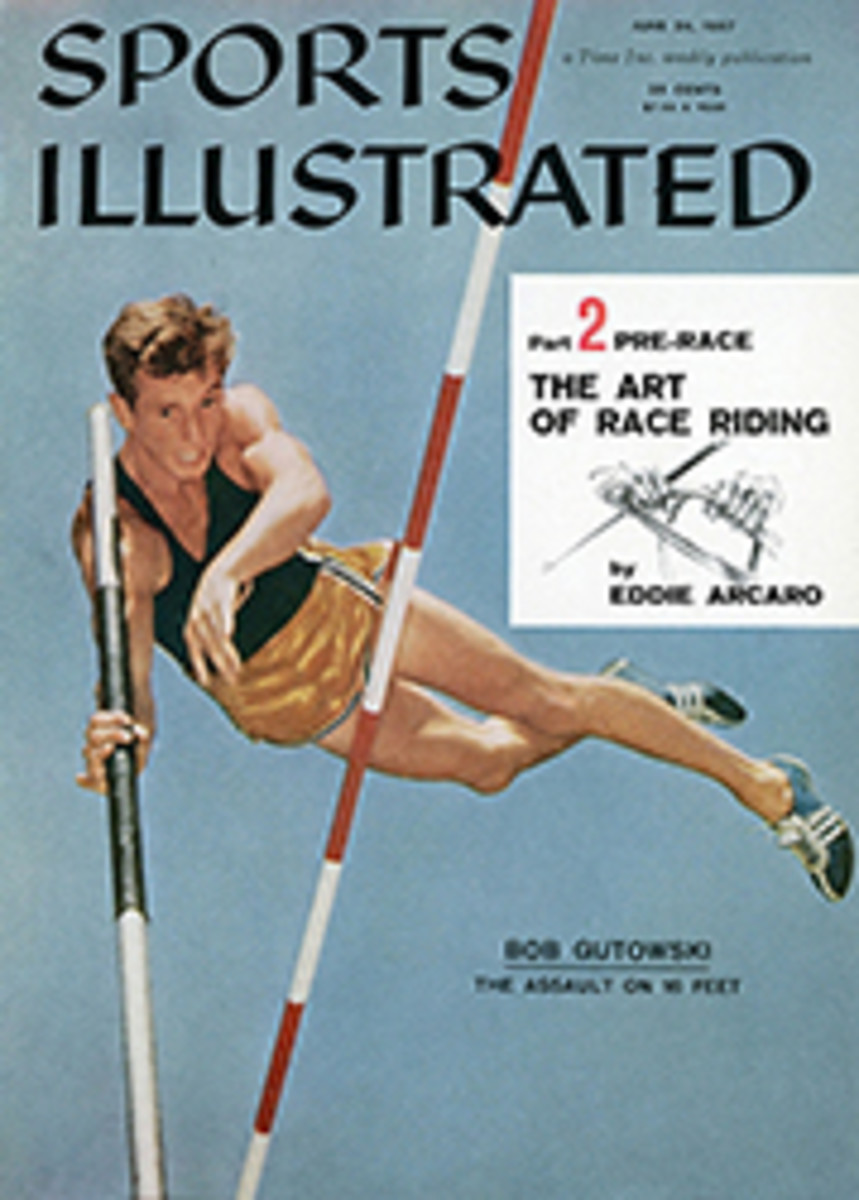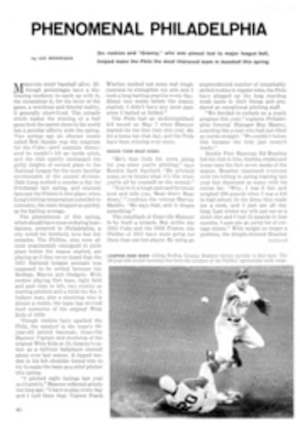
PHENOMENAL PHILADELPHIA
Miracles keep baseball alive. Although percentages have a distressing tendency to catch up with it, the miraculous is, for the lover of the game, a wondrous and blissful reality, if generally short-lived. The miracle which makes the winning of a ball game look the easiest chore in the world has a peculiar affinity with the spring. Two springs ago an obscure rookie called Bob Speake was the magician for the Cubs—until someone discovered he couldn't hit an inside pitch, and the club quietly exchanged the giddy heights of second place in the National League for the more familiar environment of the second division. Dale Long worked a wonder a day for Pittsburgh last spring, and stunned fans saw the Pirates in first place; when Long's hitting temperature subsided to normalcy, the team dropped as quickly as his batting average.
The phenomenon of this spring, which should have more enduring foundations, occurred in Philadelphia, a city noted for brotherly love but few miracles. The Phillies, who were almost unanimously consigned to sixth place before the season started, are playing as if they never heard that the 1957 National League pennant was supposed to be settled between the Redlegs, Braves and Dodgers. With rookies playing first base, right field and part time in left, two rookies as starting pitchers and a third the No. 1 bullpen man, plus a shortstop who is almost a rookie, the team has revived fond memories of the original Whiz Kids of 1950.
Though rookies have sparked the Phils, the catalyst is the team's 30-year-old second baseman, Granville Hamner. Captain and shortstop of the original Whiz Kids at 23, Granny's career as a fulltime ballplayer seemed about over last season. A ripped tendon in his left shoulder forced him to try to make the team as a relief pitcher this spring.
"I pitched eight innings last year and hated it," Hamner reflected grimly not long ago. "I have to play every day and I told them that. Trainer Frank Wiechec worked out some real rough exercises to strengthen my arm and I took a long batting practice every day. About two weeks before the season started, I didn't have any more pain when I batted or fielded."
The Phils had an undistinguished 8-9 record on May 7 when Hamner started for the first time this year. He hit a home run that day, and the Phils have been winning ever since.
MAKES THEM BEAR DOWN
"He's that little bit extra going for you when you're pitching," says Rookie Jack Sanford. "He pitched some, so he knows what it's like when you're all by yourself on the mound."
"You're in a tough spot and he comes over and tells you, 'Bear down. Bear down,' " confirms the veteran Harvey Haddix. "He says that, and it means something."
The comeback of Granville Hamner is by itself a miracle. But unlike the 1955 Cubs and the 1956 Pirates, the Phillies of 1957 have more going for them than one hot player. By using an unprecedented number of remarkably skilled rookies in regular roles, the Phils have plugged up the long standing weak spots in their lineup and produced an exceptional pitching staff.
"We decided to embark on a youth program this year," explains Philadelphia General Manager Roy Harney, sounding like a man who had just filled an inside straight. "We couldn't before this because the kids just weren't ready."
Rookie First Baseman Ed Bouchee led the club in hits, doubles, triples and home runs the first seven weeks of the season. Bouchee impressed everyone with his hitting in spring training last year but depressed as many with his excess fat. "Why, I was 6 feet and weighed 200 pounds when I was a kid in high school. In the Army they made me a cook, and I just ate all day long. Last winter my wife put me on a strict diet and I lost 25 pounds in four months. I sure ate an awful lot of cottage cheese." With weight no longer a problem, the dimple-chinned Bouchee has not only been hitting hard but also improving daily as a fielder.
Rookie Right Fielder Bob Bowman led the team in hitting and showed he had one of the strongest arms in the league. A wild fast-ball pitcher and an all-round athlete in high school, Bowman went into organized baseball as an experiment. "I had quit San Jose State because I wasn't getting anything out of school. I had gone there on a football scholarship and didn't know what I wanted to do. One day a friend of mine talked me into going to a tryout camp and I finally made it as an outfielder when I couldn't make it as a pitcher."
When ex-Cardinal Rip Repulski, the regular left fielder, injured himself early in the season, an obscure rookie named Harry Anderson stepped into the lineup. Anderson, an infielder before last year, batted only .235 with Schenectady in 1956.
Manager Mayo Smith says: "We threw that .235 average out the window after seeing Harry swing in spring training. After all, he didn't get out of the Army until June, and he hadn't gotten his timing back. He's going to be a good hitter."
The last big gap in the Phillie defense was filled when Shortstop Chico Fernandez came from the Dodgers just before the season started. Booed at first by the Phillie fans, the cocky Fernandez has teamed with Hamner to give the Phils a long-needed major league double-play combination. His play at short has stopped the jeers. His speed on the bases has now earned him the accolade of the steady chant, "Go, go, go," every time he gets on base.
Most impressive of all has been the Philadelphia pitching. Through Memorial Day the Phils played good .579 ball and were in fourth place, three games out of first. But they had won only three of the ten games they had played with the Dodgers, Braves and Redlegs, the teams they would have to beat if they were to be taken seriously. One week later, the Phils had won three out of four from the Dodgers and two out of three from the Redlegs and were just 30 percentage points away from first place. But in that week the Philadelphia hitters had scored an average of barely three runs per game, hardly enough ordinarily to beat the Dodgers and the Redlegs. The Philadelphia pitchers, however, had allowed an average of only two runs a game.
DEEPEST STAFF
"I said last January that the Phils staff would be the deepest in the league," Roy Harney comments. "I knew we would have Harvey Haddix for a full season, Curt Simmons fully recovered from his arm troubles and Robin Roberts still capable of being one of the best in the league. I also knew we had some real good young pitchers coming up."
Three rookie pitchers, in particular, have been electrifying. When Pitching Coach Whitlow Wyatt first saw the 28-year-old rookie fast-baller, Jack Sanford, throw last September, his astonished question was: "Where has that boy been all this time? He's got one of the best arms I've ever seen."
Sanford was on terminal leave after two years in the Army and seven years in the minor leagues. He always had an exceptionally fast ball and a good curve but lacked control. "Wyatt changed the position of my thumb and had me roll my wrist more. Now I consistently put the ball where I want it."
With only three years of organized ball behind him, Don Cardwell, the youngest of all the rookies at 21, has perhaps the most promising future. Big (6 feet 4 inches, 210 pounds) and strong, the soft-spoken native of Winston-Salem, N.C. was supposed to be a year away this spring but impressed so with his poise, fast ball and curve that he has become a regular starter on the staff. "I like the big crowds up here. I feel a bit funny before the first pitch, but after I start working it doesn't faze me. I always feel better when I think of those hard-throwing young pitchers the Phils had in spring training. Man, they were fast. It keeps me on my toes thinking about them waiting to come up here."
The third rookie, Right-hander Dick Farrell, has an uncomplicated attitude: "I'm not what you would call cocky. But I do know that I can get any batter out." Determination to overcome the effects of a four-year siege of polio in his youth which left his left leg slightly impaired made Farrell into a high school football, basketball and baseball star at Brookline, Mass. "A Dodger scout wanted to sign me as an outfielder. But I knew I couldn't hit a curve ball." Extreme self-confidence and a sharp, sinking last ball have made Farrell the Phillies' No. 1 late-inning bullpen specialist.
Reason rejects the Phillies as a serious pennant threat. It is sufficiently extraordinary that they are the most improved team of the 1957 season.
"It would really be a miracle if we win it this time," says Roy Harney. "We'll be more than pleased if the kids improve over the rest of the year. Then in '58 we'll be a definite pennant contender."
Mayo Smith, a quiet, easy-going manager, echoes the mature sentiment: "Regardless of what happens this season, we're going to be in good shape for the future. The boys are all pretty darn cool under fire, and they feel they can win it all. Some of the fuzz is off their cheeks."
PHOTO
LEAPING HIGH OVER sliding Redleg, Granny Hamner throws quickly to first base. The 30-year-old second baseman has been the catalyst of the Phillies' spectacular early surge.
HIGHLIGHT
It was daffy, but true. For the second successive year, the National League pennant race reached mid-June with five teams bunched near the top of the standings. Last year Cincinnati, Brooklyn, Milwaukee, Pittsburgh and St. Louis were the contenders, all within a handshake of first place. This year the same teams are involved with one exception: Philadelphia has replaced Pittsburgh.
Close races create curious situations. This year for a seven-day stretch beginning June 7, the Dodgers were never in the same position two days in a row. They danced from second to first to second, then to third and fourth, up to second again and finally back down to fourth. Meanwhile during the same week, Cincinnati managed to leapfrog from first to third to first to third without ever being in second. It was possible for a team to win a game and lose a position or lose a game and gain a position.
But if the two mid-June National League pennant races were similar their heroes were not. The big 1956 names were not pulling their 1957 weight. Boyer, Long and Snider had been replaced by such as Hoak, Cimoli and Sanford. And Don Newcombe, Johnny Antonelli and Bob Friend had all lost more games than they had won.
Perhaps the tight race worried Milwaukee most of all. After all, they had lost by one game last year. Therefore, in a move which could—and many thought should—have been made last winter, the Braves obtained veteran (34) Red Schoendienst from the New York Giants. Schoendienst, a steady fielder and perennial .300 hitter who is leading the early polling for the National League All-Star second baseman's berth, ought to provide Milwaukee with the edge they need to win the pennant. If he doesn't, the Braves may be sorry they ever left Boston.

